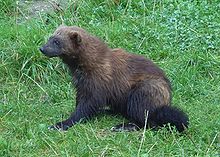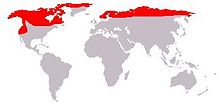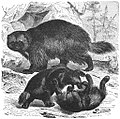Wolverine: Difference between revisions
m Reverted edits by Brennen3462 to last version by SheepNotGoats (HG) |
Brennen3462 (talk | contribs) No edit summary |
||
| Line 176: | Line 176: | ||
Image:Wolverine display at Arctic Interagency Visitor Center at Coldfoot.jpg |
Image:Wolverine display at Arctic Interagency Visitor Center at Coldfoot.jpg |
||
</gallery> |
</gallery> |
||
*[[Badger]] |
|||
{{Mustelidae nav}} |
{{Mustelidae nav}} |
||
Revision as of 13:32, 12 December 2008
| Wolverine[1] | |
|---|---|

| |
| Scientific classification | |
| Kingdom: | |
| Phylum: | |
| Class: | |
| Order: | |
| Family: | |
| Genus: | Gulo Pallas, 1780
|
| Species: | G. gulo
|
| Binomial name | |
| Gulo gulo (Linnaeus, 1758)
| |

| |
| Wolverine range | |
The wolverine (Gulo gulo) is the largest land-dwelling species of the Mustelidae or weasel family (the Giant Otter is largest overall) in the genus Gulo (meaning "glutton"). It is also called the Glutton or Carcajou. Some authors recognize two subspecies: the Old World form Gulo gulo gulo and the New World form G. g. luscus. A third subspecies limited to Vancouver Island (G. g. vancouverensis) is also occasionally described; however, craniomorphic evidence suggests that the Vancouver Island wolverines are properly included within G. g. luscus.
Anatomy
Anatomically, the wolverine is a stocky and muscular animal. It has brown hair with stripes of dull yellow along the sides. Its fur is long and dense and does not retain much water, making it very resistant to frost, which is common in the wolverine's cold habitat. (For these reasons, the fur has been traditionally popular among hunters and trappers as a lining in jackets and parkas, especially for wear in Arctic conditions). The adult wolverine is about the size of a medium dog, with a length usually ranging from 65 – 87 cm (25 – 34 inches), a tail of 17 – 26 cm (7 – 10 inches), and weight of 9 – 17 kg (22 – 36 lb), sometimes over 30 kg (66 lb).[3] The males are as much as 30 percent larger than the females. In appearance, the wolverine resembles a small bear with a long tail. It has been known to give off a very strong, extremely unpleasant odor, giving rise to the nicknames "skunk bear" and "nasty cat." Wolverines, as other mustelids, possess a special upper molar in the back of the mouth that is rotated 90 degrees, or sideways, towards the inside of the mouth. This special characteristic allows wolverines to tear off meat from prey or carrion that has been frozen solid and also to crush bones, which enables the wolverine to extract marrow.[4][5]
Behavior

The wolverine is, like most mustelids, remarkably strong for its size. It has been known to kill prey as large as moose, although most typically when these are weakened by winter or caught in snowbanks. Wolverines inhabiting the Old World (specifically, Fennoscandia) are more active hunters than their North American cousins.[6] This may be because competing predator populations are not as dense, making it more practical for the wolverine to hunt for itself than to wait for another animal to make a kill and then try to snatch it. They often feed on carrion left by wolves, so that changes in the population of wolves may affect the population of wolverines.[7] Wolverines are also known on occasion to eat plant material.[8]
Armed with powerful jaws, sharp claws, and a thick hide,[9] wolverines may defend kills against larger or more numerous predators.[10] There is at least one published account of a 27-pound wolverine's attempt to steal a kill from a black bear (adult males weigh 400 to 500 pounds). Unfortunately for the mustelid, the bear won what was ultimately a fatal contest.[11]
Mating season is in the summer, but the actual implantation of the embryo (blastocyst) in the uterus is stayed until early winter, delaying the development of the fetus. Females will often not produce young if food is scarce. The wolverine gestation period is 30-50 days. Litters of typically two or three young ("kits") are born in the spring. Kits develop rapidly, reaching adult size within the first year of a lifespan that may reach anywhere from five to (in exceptional individuals) thirteen years.[citation needed]
Adult wolverines have no natural predators, though they do come into conflict with (and may be killed by) other large predators over territory and food. Juveniles are of course more vulnerable; infants (kits) have been known on occasion to be taken by predatory birds such as eagles.[12]
Range

The wolverine lives primarily in isolated northern areas, for example the arctic and alpine regions of Alaska, northern Canada, Siberia and Scandinavia; they are also native to Russia and the Baltic countries. The wolverine is arguably found as far south as the Sierra Nevada[13] in California, and a few remain in the Rocky Mountains and northern Cascades of the United States. However most of the Wolverines live in Canada.[8]
The world's total wolverine population is unknown. The animal exhibits a low population density and requires a very large home range.[7] The range of a male wolverine can be more than 620 km² (240 sq mi) while encompassing the ranges of several females (with smaller home ranges of roughly 130-260 km² (50-100 sq mi). Adult wolverines try for the most part to keep non-overlapping ranges with adults of the same sex.[5] Radio tracking suggests an animal can range hundreds of miles in only a few months.
| Country | Population | Area | Year | State of Population |
|---|---|---|---|---|
| Sweden | 265+[14] | Norrbotten[14] | 1995-97[14] | Stable[14] |
| Norway | 150+[14] | Snøhetta plateau and North[14] | 1995-97[14] | Decline[14] |
| Finland | 115[14] | Karelia and North[14] | 1997[14] | Stable[14] |
| Russia | 1500[14] | Taiga[14] | 1970, 1990, [14] | Decline[14] |
| Russia - Komi | 885[14] | - | 1990[14] | - |
| Russia - Archangelsk Oblast | 410[14] | Nenetsky Autonomous Area[14] | 1990[14] | Limited[14] |
| Russia - Kola Peninsula | 160[14] | Hunting Districts[14] | 1990[14] | Decline[14] |
| USA - Alaska[15] | unknown[15] | Kobuk Valley National Park[15], Selawik National Wildlife Refuge[15] | 1998[15] | Decline[15] |
| USA - Alaska[16] | 3.0 (± 0.4 SE) wolverines/1,000 km2[16] | Turnagain Arm and the Kenai Mountains[16] | 2004[16] | -[16] |
| USA - California[7] | Unknown | Tahoe National Forest[7] | 2008[7] | Unknown[7] |
| Canada - Yukon | 9.7 (± 0.6 SE) wolverines/1,000 km2[16] | Old Crow Flats[16] | 2004[16] | -[16] |
| Canada - Ontario[17] | unclear[17] | Red Lake – Sioux Lookout to Fort Severn – Peawanuck[17] | 2004[17] | Stable to Expanding[17] |
| Canada - Overall[18] | 15000 to 19000[18] | Overall[18] | -[18] | Stable[18] |
This requirement for large territories brings wolverines into conflict with human development, and hunting and trapping further reduce their numbers, causing them to disappear from large parts of their former range; attempts to have them declared an endangered species have met with little success.[7]
Name
The wolverine's (questionable) reputation as an insatiable glutton may be in part due to a false etymology. The animal's name in old Swedish, Fjellfräs, meaning "fell (mountain) cat", worked its way into German as Vielfraß, which means roughly "devours much". Its name in other West Germanic languages is similar (e.g. Dutch Veelvraat). The name in Old Norse, Jarfr, lives on in the regular Icelandic name jarfi, regular Norwegian name jerv, regular Swedish name järv and regular Danish name jærv. The Finnish name is Ahma, which is derived from "ahmatti" which also is precisely translated as "glutton".
As a symbol
The Norwegian municipality of Bardu and Finnish municipality of Kittilä have a wolverine in their coats-of-arms.
The U.S. state of Michigan is, by tradition, known as "The Wolverine State," and the University of Michigan takes the wolverine as its mascot. Many other educational institutions utilized the wolverine as an athletic mascot (e.g., Bronx High School of Science and Utah Valley University). A major league baseball team from the 1880s was also popularly known as the "Detroit Wolverines". The association is well and long established: for example, many Detroiters volunteered to fight during the American Civil War and George Armstrong Custer, who led the Michigan Brigade, called them the "Wolverines." The origins of this association are obscure: it may derive from a busy trade in wolverine furs in Sault Ste. Marie in the 18th century or may recall a disparagement intended to compare early settlers in Michigan with the vicious mammal. In any event, the animal appears no longer to be indigenous to the state (and in fact may never have been). It is, at the very least, an uncommon sight there: for example, when one was observed in February 2004[19] by hunters and biologists near Ubly, it was the first confirmed sighting of a wolverine in Michigan in about two centuries. It is unknown whether that particular animal was a state native or if it migrated or had been released by humans.
The European Football League (playing American football in Europe) includes the Helsinki Wolverines,[20] founded in 1995. The team plays in the Maple League, the Finnish top level. The wolverine figures prominently in the mythology of the Innu people of eastern Québec and Labrador. In at least one Innu myth, it is the creator of the world.[21]
In the Central Interior Hockey League, founded in 1996,[22] in British Columbia, Canada, an ice hockey team team based in Hazelton, British Columbia is named the Hazelton Wolverines.[23]
References
- ^ Wozencraft, W. C. (2005). "Order Carnivora". In Wilson, D. E.; Reeder, D. M. (eds.). Mammal Species of the World: A Taxonomic and Geographic Reference (3rd ed.). Johns Hopkins University Press. pp. 532–628. ISBN 978-0-8018-8221-0. OCLC 62265494.
- ^ Template:IUCN2008
- ^ http://www.britannica.com/EBchecked/topic/646740/wolverine
- ^ Pratt, Philip. "Dentition of the Wolverine". The Wolverine Foundation, Inc. Retrieved 2007-07-01.
- ^ a b Taylor, Ken (1994). "Wolverine" (HTML Public). Wildlife Notebook Series. Alaska Department of Fish & Game. Retrieved 2007-01-21.
- ^ World Wildlife Fund–Sweden: 1st International Symposium on Wolverine Research and Management (PDF)
- ^ a b c d e f g "Wolverine wonder", Grist.org, March 4, 2008; also Associated Press (2008-03-10). "Student's camera snaps wolverine in California". CNN.com. Retrieved 2008-03-11.
- ^ a b Rickert, Eve (June 28, 2007), "The perils of secrecy", High Country News
{{citation}}: CS1 maint: date and year (link) - ^ World Biomes: Wolverine
- ^ YouTube: Wolverine challenges bear to leave
- ^ "When Predators Attack (Each Other): Researchers Document First-known Killing Of A Wolverine By A Black Bear In Yellowstone" (Press release). Science Daily. 2003-05-06. Retrieved 2007-01-16.
{{cite press release}}: Check date values in:|date=(help) - ^ Hinterland Who’s who: Wolverine
- ^ Knudson, Tom (March 5, 2008), "Elusive wolverine makes its first Sierra appearance in years", Sacramento Bee
{{citation}}: CS1 maint: date and year (link) - ^ a b c d e f g h i j k l m n o p q r s t u v w x y z Arild Landa, Mats Lindén and Ilpo Kojola (2000). "Action Plan for the conservation of Wolverines (Gulo gulo) in Europe" (PDF). Nature and environment, No. 115. Convention on the Conservation
of European Wildlife and Natural Habitats (Bern Convention). Retrieved 2008-01-25.
{{cite web}}: line feed character in|publisher=at position 31 (help) - ^ a b c d e f Brad Shults, Gene Peltola, Jerrold Belant and Kyran Kunkel (12/17/98). "population ecology of wolverines within Kobuk valley national park and Selawik national wildlife refuge". Rocky Mountain Research Station, US Department of Agriculture - Forest Service. Retrieved 2008-01-26.
{{cite web}}: Check date values in:|date=(help)CS1 maint: multiple names: authors list (link) - ^ a b c d e f g h i
Howard N. Goldena, J. David Henryb, Earl F. Beckera, Michael I. Goldsteinc, John M. Mortond, Dennis Frost, and Aaron J. Poef (12/17/98). "Estimating wolverine Gulo gulo population size using quadrat sampling of tracks in snow". Alaska Department of Fish and Game, Division of Wildlife Conservation; Parks Canada - Kluane National Park; US Forest Service - Alaska Regional Office; United States Fish and Wildlife Service, Kenai National Wildlife Refuge; North Yukon Renewable Resources Council; United States Forest Service, Chugach National Forest;. Retrieved 2007.
{{cite web}}: Check date values in:|accessdate=and|date=(help)CS1 maint: extra punctuation (link) CS1 maint: multiple names: authors list (link) - ^ a b c d e Dr. Audrey Magoun, Neil Dawson, Dr. Geoff Lipsett-Moore, Dr. Justina C. Ray (2004). "Boreal Wolverine: A Focal Species for Land Use planning in Ontario's Northern Boreal Forest - Project Report" (PDF). The Wolverine Foundation, Inc., Ontario Ministry of Natural Resources, Ontario Parks, Wildlife Conservation Society (WCS)/University of Toronto. Retrieved 2008-01-26.
{{cite web}}: CS1 maint: multiple names: authors list (link) - ^ a b c d e
Brian Slough; et al. (2003). "COSEWIC Assessment and Update Status Report on the Wolverine (Gulo gulo) - Eastern Population Western Population in Canada" (PDF). COSEWIC (committee on the status of endangered wildlife in Canada) 2003. COSEWIC assessment and update status report on the wolverine Gulo gulo in Canada. Committee on the Status of Endangered Wildlife in Canada. Ottawa. vi + 41 pp. Retrieved 2008-01-26.
{{cite web}}: Explicit use of et al. in:|author=(help); Unknown parameter|month=ignored (help) - ^ MSNBC: First Michigan wolverine spotted in 200 years
- ^ Helsinki Wolverines
- ^ Armitage, Peter (1992). "Religious ideology among the Innu of eastern Quebec and Labrador" (PDF). Religiologiques. 6. Retrieved 2007-06-29. (PDF)
- ^ CIHL
- ^ Hazelton Wolverines
External links
- Large Carnivore Initiative for Europe: Wolverine: scientific articles about wolverines



